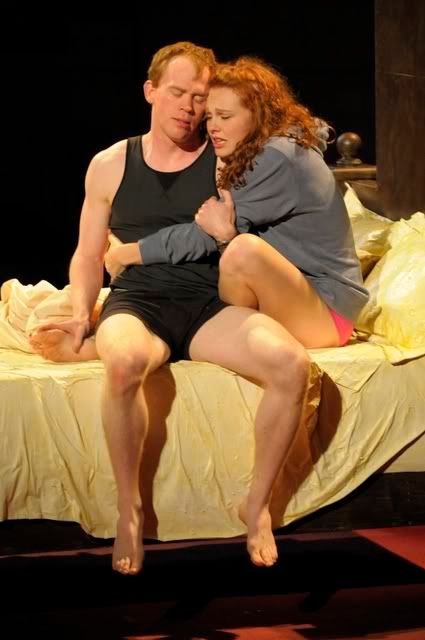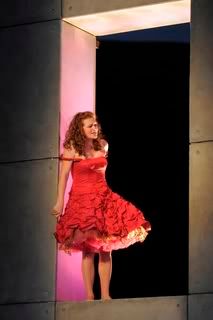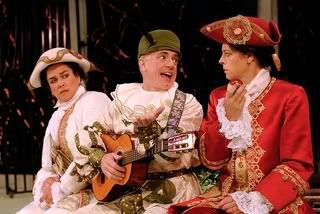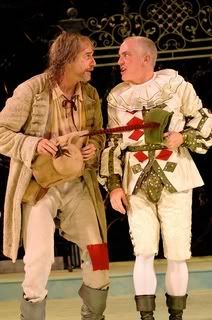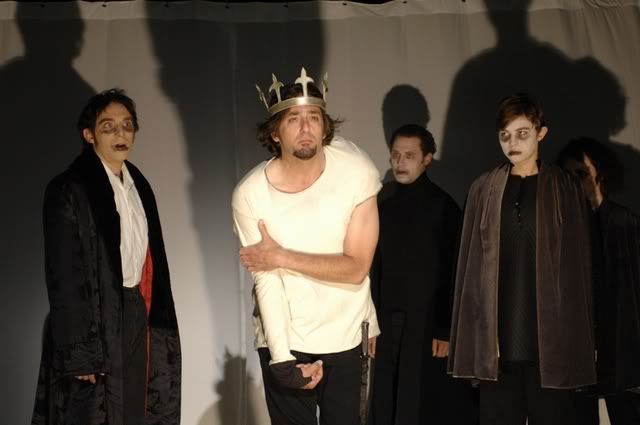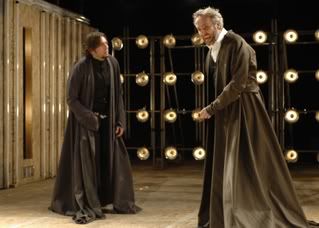Opened May 30, 2009 at the Bruns Amphitheater
Alex Morf and Sarah Nealis are the star-crossed young lovers in the California Shakespeare Theater’s season-opening production of Romeo and Juliet. Photos by Kevin Berne
Youthful passion, ancient hate heat up Cal Shakes’ `R&J’
««« ½
An explosion of color, violence and surprising beauty, the giant splash of graffiti that dominates the cement-heavy set of California Shakespeare Theater’s season-opening Romeo and Juliet pretty much says it all.
Designer Neil Patel doesn’t bother with too many scenic flourishes. Two important pieces of furniture – a detailed sculpture of virgin and child and a heavy wooden bed – are on stage at all times, and except for a formal door, the only other opening in the imposing walls is a window platform just perfect for balcony romancing.
The colorful graffiti design, like something that Romeo and his compatriots might wear on a stylish T-shirt, is a youthful burst of energy amid the austerity and dark violence of Verona.
It’s a fitting stage for director Jonathan Moscone’s highly charged, deeply felt production, which opens Cal Shakes’ 35th anniversary season.
The first half of the show, as full of bloody battles as it is heart-melting courtship, is especially riveting. Dave Maier’s fight choreography (which makes great use of violently flung chairs) conveys the tension and drama of the age-old battle between the Capulets and Montagues, while MaryBeth Cavanaugh’s dance choreography – to the pop and dance tunes of Andre Pluess’ sound design – makes the Capulet’s masked ball a fizzy backdrop for Romeo and Juliet to fall in love at first sight.
What makes this production truly connect is Moscone’s choice to make Romeo and Juliet believable teenagers. From the first moments of the show, when we see young Montagues and Capulets with skateboards, iPods and cell phones (in everyday clothes by costumer Raquel M. Barreto), it’s clear that this is a fresh, youthful take on the story. When we meet Romeo (Alex Morf), he’s lovelorn and sappy, sick with love for a girl who has rebuffed him. He lays it on pretty thick, which is why it’s so fun to see his Vespa-driving compatriots Benvolio (Thomas Azar) and Mercutio (Jud Williford) having so much fun at his expense.
Our first glimpse of Juliet (Sarah Nealis) has her staring out the window (awash in the pink light of Russell H. Champa’s expert design), lost in her iPod.
The two meet and fall in love as teenagers. From the famous balcony scene – as giddily romantic and as deadly serious as I’ve seen – up to the tragic chaos that ends their lives, these young people mature before our eyes, especially Juliet, whose resolve and emotional depth are beautifully conveyed by Nealis.
Catherine Castellanos as Juliet’s nurse nearly steals the show. From her fond, gushing remembrance of nursing Juliet as a baby to her soul-deep aching for her young mistress’ troubles, this nurse is as funny as she is moving. Wiliford’s fiery Mercutio leaves an equally strong impression. He and Castellanos have a memorable interaction, with Mercutio relentlessly teasing the nurse (he even bids adieu to her with a serenade of Styx’s “Lady”), but his best work is alongside his comrades.
The second half of the play, with all its weeping and wailing, can’t match the highs of the first half, obviously. Dan Hiatt is terrific as the helpful Friar Lawrence, and the adult Capulets (James Carpenter and Julie Eccles) and Montagues (L. Peter Callender and Castellanos again) all have powerful moments, but the final tragedy, amid the flickering torchlight of the Capulet tomb, didn’t land as solidly (at least not on a chilly opening night) as the rest of the play.
Still, there are indelible images from this production: the flutter of rose petals through a window, the prodigious puddles of blood under slain Mercutio and Tybalt (Craig Marker) and the sweet, sweet flush of first love between teenagers, whose bond has the power to change the world.
FOR MORE INFORMATION
California Shakespeare Theater’s Romeo and Juliet continues through June 21 at the Bruns Amphitheater, 100 Gateway Blvd., Orinda (one mile east of the Caldecott Tunnel on Highway 24). Tickets are $20-$63. Call 510-548-9666 or visit www.calshakes.org for information. There’s a free shuttle to and from the theater and the Orinda BART station.
Cal Shakes maintains quite an interesting blog, taking readers behind the scenes of its productions. Check it out here.

